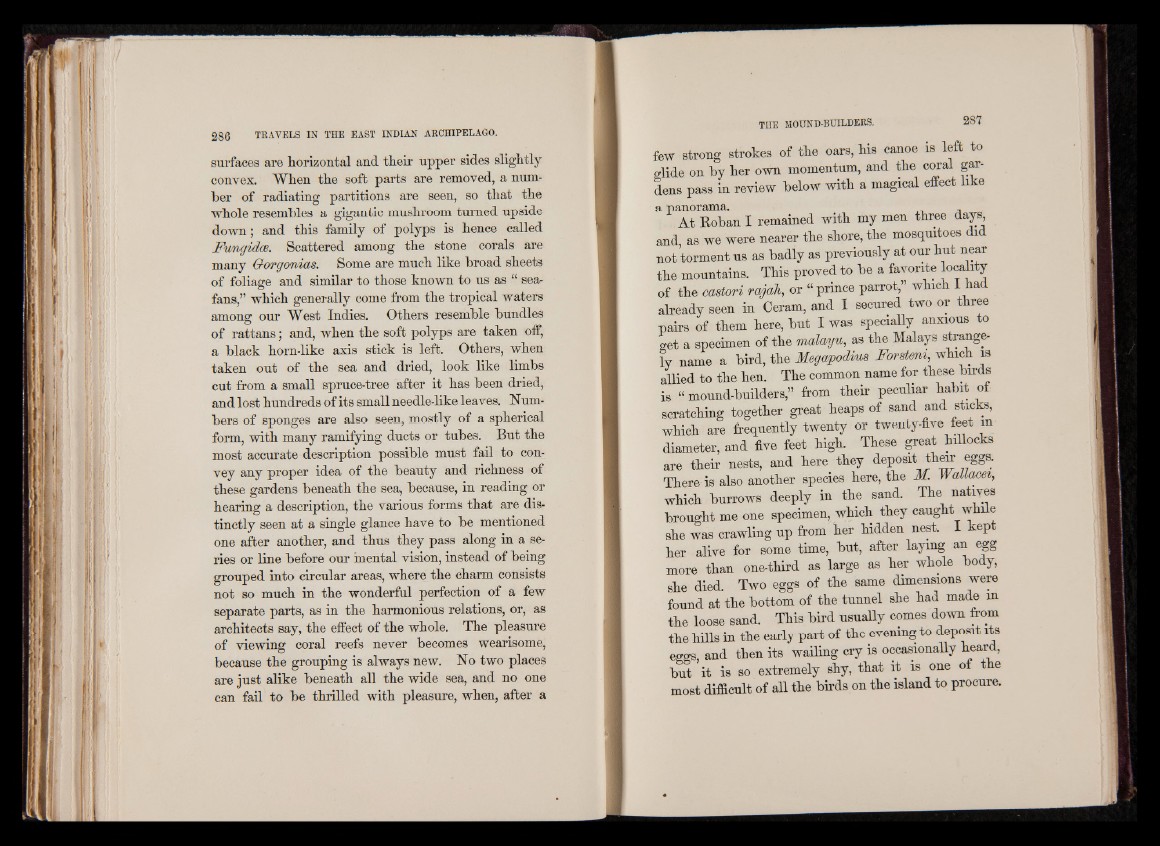
surfaces are horizontal and their upper sides slightly
convex. When the soft parts are removed, a number
of radiating partitions are seen, so that the
whole resembles a gigantic mushroom turned upside
down; and this family of polyps is hence called
Fungidce. Scattered among the stone corals are
many Gorgonias. Some are much like broad sheets
of foliage and similar to those known to ns as “ sea-
fans,” which generally come from the tropical waters
among our West Indies. Others resemble bundles
of rattans; and, when the soft polyps are taken off,
a black horn-like axis stick is left. Others, when
taken out of the sea and dried, look like limbs
cut from a small spruce-tree after it has been dried,
and lost hundreds of its small needle-like leaves. Numbers
of sponges are also seen, mostly of a spherical
form, with many ramifying ducts or tubes. But the
most accurate description possible must fail to convey
any proper idea of the beauty and richness of
these gardens beneath the sea, because, in reading or
hearing a description, the various forms that are distinctly
seen at a single glance have to be mentioned
one after another, and thus they pass along in a series
or line before our mental vision, instead of being
grouped into circular areas, where the charm consists
not so much in the wonderful perfection of a few
separate parts, as in the harmonious relations, or, as
architects say, the eifect of the whole. The pleasure
of viewing coral reefs never becomes wearisome,
because the grouping is always new. No two places
are just alike beneath all the wide sea, and no one
can fail to be thrilled with pleasure, when, after a
few strong strokes of the oars, his canoe is left to
glide on by her own momentum, and the coral gardens
pass in review below with a magical effect like
a panorama.
At Eoban I remained with my men three days,
and as we were nearer the shore, the mosquitoes did
not torment us as badly as previously at our hut near
the mountains. This proved to be a favorite locality
of the castori rajah, or “ prince parrot,” which I had
already seen in Ceram, and I secured two or three
pairs of them here, but I was specially anxious to
get a specimen of the malmju, as the Malays strangely
name a bird, the Megwpodius Forsteni, which is
allied to the hen. The common name for these birds
is “ mound-builders,” from their peculiar habit of
scratching together great heaps of sand and sticks,
which are frequently twenty or twenty-five feet m
diameter, and five feet high. These great hillocks
are their nests, and here they deposit their eggs.
There is also another species here, the M. WaTUw&i,
which burrows deeply in the sand. The natiyes
brought me one specimen, which they caught while
she was crawling up from her hidden nest. I kept
her alive for some time, but, after laying an egg
more than one-third as large as her whole body,
she died. Two eggs of the same dimensions were
found at the bottom of the tunnel she had made m
the loose sand. This bird usually comes down from
the hills in the early part of the evening to deposit its
eggs, and then its wailing cry is occasionally heard,
but it is so extremely shy, that it is one of t e
most difficult of all the birds on the island to procure.